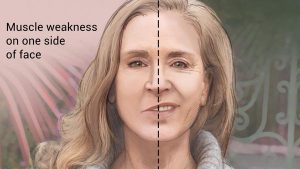What is Bell’s palsy :
- Bell’s palsy is a condition in which the muscles on one side of your face become weak or paralyzed. It affects only one side of the face at a time, causing it to droop or become stiff on that side. It’s caused by some kind of trauma to the seventh cranial nerve. This is also called the “facial nerve.”Bell’s palsy is a paralysis or weakness of the muscles on one side of the face. The cause is unknown, although infection or autoimmune responses are suspected. The majority of people with Bell’s palsy, around 90 percent, will recover completely with time.

How does the disease occur :
- Bell’s palsy may be a reaction to a viral infection. It rarely occurs more than once.
- Bell’s palsy is characterized by muscle weakness that causes one half of the face to droop.
- Bell’s palsy usually resolves on its own within six months. Physiotherapy can help prevent muscles from permanently contracting.
Symptoms of the Disease :
Bell’s palsy is characterised by muscle weakness that causes one half of the face to droop.
People may suffer :
– Pain areas: in the ear
– Sensory: abnormality of taste or sensitivity to sound
– Also common: facial muscle weakness, drooling, or dry eyes
Treatment for the disease :
1 – Therapies
Physical Therapy :
Restores muscle strength and function through exercise.
2 – Medications
Steroid
Modifies or simulates hormone effects, often to reduce inflammation or for tissue growth and repair.
Antiviral drug
Reduces viruses’ ability to replicate.
3 – Self-care
Artificial tears
Moistens eyes to provide soothing relief.
4 – Devices
Eyepatch
A covering used to protect the eye from injury.
5 – Specialists
Physiotherapist
Restores muscle strength and function through exercise.
Neurologist
Treats nervous system disorders.
Primary Care Provider (PCP)
Prevents, diagnoses and treats diseases.
Emergency Medicine Doctor
Treats patients in the emergency department.
Econimcal Factors :
Of the total study group, 67% had acquired facial palsy. The mean age of the total group was 44.7 years and 67.9% were female. As a group they were rather less depressed than the normal population with similar levels of anxiety to population norms. The primary motivation for surgery was appearance rather than function. Using interview data in addition to the FPEM, satisfaction with the process and outcome of surgery was assessed. Thirty five percent were very satisfied with both process and outcome, 34% were satisfied with the outcome but found the treatment process stressful, 15.1% were not entirely satisfied with process or outcome but felt surgery had been worthwhile as there had been some improvement.